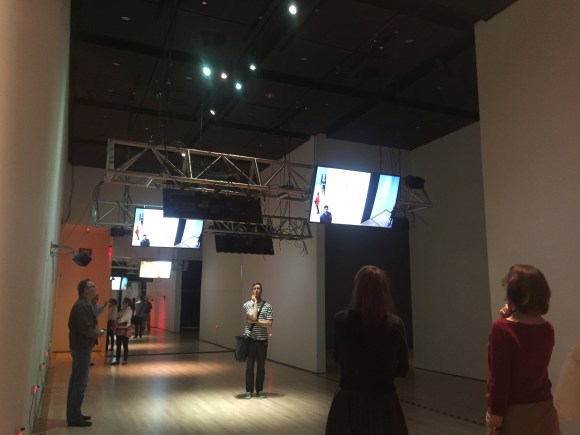
Artist Julia Scher’s installation Predictive Engineering has had a permanent home at the San Francisco Museum of Modern Art (SFMOMA) since 1998. In a poignant commentary on mass surveillance, the artist laced real security footage with jarring clips of back-alley shenanigans and men and women frolicking nude through the museum itself. As the art evolved across decades, so too did its equipment, documentation, and space requirements.
After closing its doors in 2013 for a major expansion, SFMOMA reopened in May with new new galleries, exhibitions and a comprehensive catalog of artwork. Though most of the museum’s staff is directly involved with these featured artworks, not everyone can rally the bandwidth to wade through such a wealth of information before making prompt decisions.
So how can SFMOMA’s staff, from registrars and technicians to curators, quickly make sense of Predictive Engineering, a complex entanglement of gallivanting, wires and media files? The museum looked to the Wikimedia Foundation, two blocks east, for inspiration.
Today, they’re experimenting with MediaWiki, the software Wikipedia was built on, to provide context for Scher’s latest version of Predictive Engineering (PE3). PE3 is just one of over 300 of SFMOMA’s media works: interactive art installations with a dizzying amount of moving parts.
The MediaWiki page for PE3 features installation instructions, PDFs, quick-reference equipment lists, previous iteration descriptions, a technical narrative, audio and video streams, and the artwork’s approved curatorial description—everything SFMOMA staff might need to install, reference, lend, or discuss the work. It also provides something the primary database can’t: rich context, like audio and video interviews, press reviews, correspondences, and interpretive texts. It’s a user-friendly way to compile documentation and capture the different voices of everyone involved. Its structure is designed to be replicable for any kind of artwork. This record will help people understand the work’s concept in the future and will inform decisions about its preservation.
In terms of complex works, media conservator Martina Haidvogl said “before a work is installed, you can’t really know what it is by just looking at its components. In order to get an idea of what the work is, while it is not on view, or to possibly even tell its story adequately once it can no longer be installed in a particular way, we started experimenting with the MediaWiki platform and we asked ourselves: how can we bring what the core of the work is to the forefront?”
SFMOMA’s latest documentation platform is gaining traction as a source for staff searching for deeper knowledge on an artist or their artwork.
The hope for MediaWiki is that sharing context on these pieces will become so effortless, pages could be dispersed to researchers or other institutions just as simply as sharing a Wikipedia page.
Installing and showing new pieces is a feat in and of itself, demanding advanced documentation of the required technology, projections, screens, lighting, floor plans, and more. PE3 in particular has evolved over decades, demanding new technology as old ones succumb to obsolescence. Their standard database tackles tracking all of these new components very well, but when it comes to context, multi-media, interface and ease of understanding, MediaWiki pulls its own weight.
The original Predictive Engineering called for CCD color surveillance cameras, two Amiga 1200 computers, unwieldy sets of speakers, video switchers and a set of CRT monitors , all of which are almost impossible to find today. Since then, the PE3 experience has grown sleeker and more streamlined, with the artist exchanging the old fare with flat screens, faster hookups, and new drone video footage for this new manifestation of her installation’s concept. The wiki provides a platform where all of this research can live in a collaborative, complex way.
So far, Haidvogl calls the museum’s MediaWiki “an experiment that shows us what is missing from our traditional databases; a platform that supports and fosters collaboration, which is such an essential part in the care of contemporary art; a technology that responds to the requirements of documenting complex works of art and provides a space, where all of this information can be captured; all the while being extremely flexible and supported by a huge open-source community.” The new, streamlined SFMOMA practices “curated information,” unfettered by logistics, leaving staff free to do what comes naturally: to put art at the center of their thinking.
Aubrie Johnson, Social Media Associate
Wikimedia Foundation

Can you help us translate this article?
In order for this article to reach as many people as possible we would like your help. Can you translate this article to get the message out?
Start translation